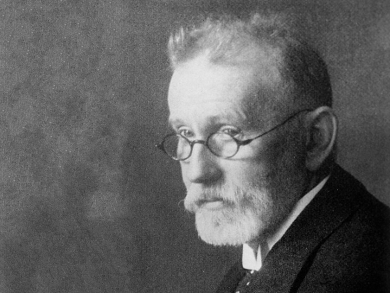Paul Ehrlich, Nobel Laureate for his work on immunology and founder of chemotherapy, was born in Strzelin, now Poland, on March 14, 1854. He attended the Universities of Breslau (Wrocław), now Poland; Strasbourg, France; Freiburg im Breisgau and Leipzig, both Germany. Ehrlich obtained his M.D. in 1878 with work on staining animal tissues. During his continued work with dyes, he developed the precursor technique to Gram staining. Ehrlich also started to test the dyes for therapeutic properties and found that methylene blue could be used as a treatment for malaria.
In 1890, Paul Ehrlich joined Robert Koch as an assistant at the Institute for Infectiuos Diseases in Berlin, Germany. There, he refocused his research on immunology. In 1896, he was appointed director of the newly founded Institute for Serum Research and Serum Testing, today’s Paul Ehrlich Institute. The work he performed there (on Emil von Behring’s serum against diphtheria) was the basis for the standardization of sera, allowing their controlled use in fighting disease.
During this time, Ehrlich also developed his “side-chain” theory of the immune response, postulating that cells have side-chain receptors that can bind and recognize infectiuos agents. For these insights, he was awarded the Nobel Prize in Physiology or Medicine 1908 together with Ilya Ilyich Mechnikov.
Later, Paul Ehrlich moved to Frankfurt am Main, Germany, and became Director of the Royal Institute of Experimental Therapy in 1899. There, he started his pioneer work on chemotherapy. He tested hundreds of substances for their medicinal effects, and after many failed attempts, he and his assistants found that the arsenic compound arsphenamine (“compound 606”) was effective as a treatment for syphilis. The substance was marketed by Hoechst AG, Germany, under the trade name “Salvarsan” starting in 1910.
The treatment was a remarkable medical advance in the time before the invention of penicillin, if not entirely uncontroversial. The drug was difficult to administer, and the side effects even lead to a court case against Ehrlich, who was ultimately exonerated. Ehrlich died in Bad Homburg, Germany, on August 20, 1915
Paul Ehrlich is the answer to Guess the Chemist (44).
References
- Paul Ehrlich – Biographical,
Nobel Lectures, Physiology or Medicine 1901-1921, Elsevier Publishing Company, Amsterdam, 1967.
Publications by Paul Ehrlich
- Address in Pathology, on Chemiotherapy,
P. Ehrlich,
Br. Med. J. 1913, 2, 353–359.
DOI: 10.1136/bmj.2.2746.353 - Studies in Immunity,
P. Ehrlich,
John Wiley & Sons, New York, 1910.
DOI: 10.5962/bhl.title.1916 - Experimental Researches on Specific Therapeutics,
P. Ehrlich,
P. B. Hoeber, New York, 1909.
DOI: 10.5962/bhl.title.17522 - Collected Studies on Immunity,
P. Ehrlich (ed.),
John Wiley & Sons, New York, 1906. - The Mutual Relations between Toxin and Antitoxin – Herter Lecture,
P. Ehrlich,
Boston Med. Surg. J. 1904, 150, 443–445.
DOI: 10.1056/nejm190404281501701 - Ueber Condensationen von aromatischen Nitrosoverbindungen mit Methylenderivaten (in German),
P. Ehrlich, F. Sachs,
Chem. Ber. 1899, 32, 2341–2346.
DOI: 10.1002/cber.189903202172 - Recent experiences in the treatment of tuberculosis (with special reference to pulmonary consumption) by Koch’s method,
P. Ehrlich,
Lancet 1891, 138, 917–920.
DOI: 10.1016/S0140-6736(01)91907-5
Also of Interest
- Paul Ehrlich: The Founder of Chemotherapy,
Fritz Stern,
Angew. Chem. Int. Ed. 2004, 43, 4254–4261.
DOI: 10.1002/anie.200460632


